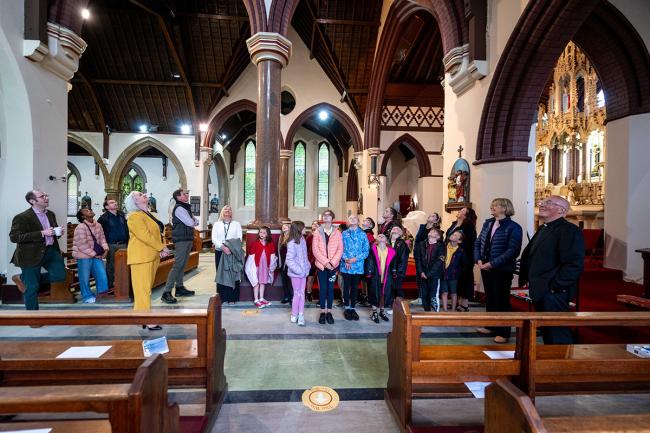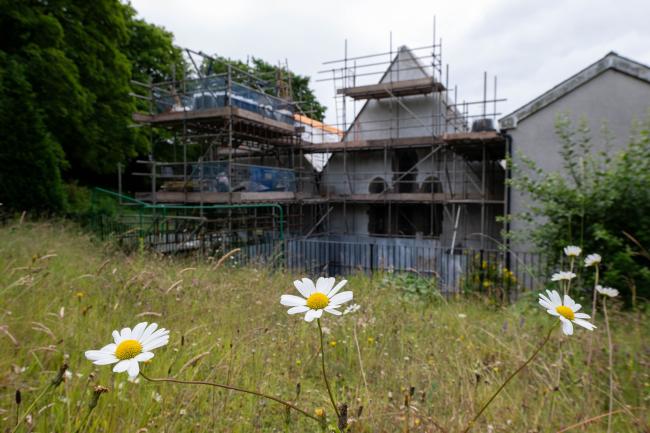St Illtyd’s Church in Merthyr Tydfil, Wales, desperately needed to remove failing asbestos tiles from their roof and make their building watertight again. They then found an ingenious way to do it – one that got local schoolchildren very excited.
About the church
“St Illtyd’s is a large church in the industrial valleys of South Wales, built in the 1840s... that great explosion of the industrial revolution where Merthyr Tydfil became the workshop of the world,” explains Owen Collins, from the Catholic Archdiocese of Cardiff, who has been supporting St Illtyd’s with their repair project.
“There was this huge influx of people working, people that paid for a Catholic place of worship in the Valleys for the first time since the Reformation. And it really was the pennies of the poor that created this large Grade II listed building.
“Of course, this is Wales, and the church is built on a ridiculously steep hillside. So usually for a Catholic church you have the first floor, which is the worship space and then underneath that you have a community centre. There's a huge amount of local community activity taking place from keep-fit classes and community choirs to warm spaces and food banks. And it is the heart of the community in many ways.”

“But sometime in the 1980s, the roof was obviously failing. And so, the decision was taken at that time to reroof the church,” says Owen.
Sadly, the new roof was made from asbestos tiles, which are hazardous as well as having a short shelf life.
“It became pretty obvious, pretty quickly before the pandemic that the roof – the entire roof – was failing all at the same time. The buckets started to come out to collect water that was penetrating the building,” continues Owen.
“Well, as always happens, emergency works were undertaken by the parish to try and plug some of those leaks. But it was clear that a major reroofing project was needed to make sure that this church could survive into the future.”

Finding hope
New roofs are very expensive. And it is up to the local congregation to fund them – there is no national fund to pay for church repair projects.
The long-term public health consequences of heavy industry – both mining and ironworks – are evident in the town, with Merthyr Tydfil in the top ten per cent for poor health outcomes in Wales. As a result, the local community is disproportionately affected by long-term disability and illness. The levels of relative poverty and illness within the area make fundraising a huge challenge.
“To make matters worse, as if matters could get much worse, we then ran into lockdown,” shares Owen.
“And that national trauma, which was the Covid 19 pandemic, caused us more delays. And this was tragic because after lockdown, inflation in the building industry went through the roof; by the time that we had re-tendered the works, the price had increased hugely.
“And that created a dynamic of hopelessness in the congregation and community because... the funding target that we were aiming for was getting further and further away every month.”

The National Churches Trust was able to help. Through our Last Chance Churches appeal, the church received £200,000 to replace their roof.
"The National Churches Trust saw the application and were kind enough to give us a grant, which really created a new sense of hope,” explains Owen.
“There was a new dynamic that a problem roof turned into a project because somebody, somewhere, had the faith that St Illtyd’s was a viable project... And once you can say that one funder is on board, other funders might be interested to help as well.”
Creative thinking
"Next to St. Illtyd’s Church there's a primary school. One of the things that we wanted to do was involve the widest possible community within this project,” says Owen.
That’s when the idea of a time capsule came up. The building needed to be completely reroofed and so the church had the brilliant idea of getting the children to write messages on the new slate tiles that were to go on the roof.

“We had conversations and meetings with the Head Teacher who was fantastic, and the school just ran with the idea and encouraged it,” continues Owen.
"And so, the idea is in 100 years' time, when this roof will also reach the end of its life, the messages of the young people of today will be there for everyone to see.
“This tied into the school curriculum in all kinds of interesting ways, through literacy but also, the teachers brought ecology and maths into it – there was even a prize for estimating how many slates were going to go onto the roof.
“They were also introducing pupils to construction as a profession and trying to get people to buy into the project. We wanted the pupils to feel a sense of ownership, that they are a part of St Illtyd’s story, just like their grandparents and great grandparents who contributed and paid for the building originally.”

The pupils were also invited to an open day, where they were able to see all their slates together, tour the church and speak with the contractors. There are also plans to invite the pupils back to plant a community orchard, including creating “bug hotels” to keep the pupils involved with the church moving forwards.
The church will now be watertight, but it also has a wider community of support through local school pupils and teachers – a relationship that will no doubt flourish for years to come.
For Churches: top tips for your place of worship
- There are a range of ways schools can be involved in your repair project, so think about what you could do and at what stage. They could observe tradespeople doing specific tasks, decorate slates and tiles or have a tour of the building before and after. These activities can help boost local fundraising efforts and help involve the community in the life of your church. They can also help give children knowledge about craft skills and heritage that could help them in thinking about their future careers. All of these options can add value to funding applications, including to the National Churches Trust and The National Lottery Heritage Fund.
- Work with teachers to ensure that risk assessments are carried out and the school is happy with your safeguarding policy in advance of any visits.
- Include the schoolchildren in any celebration efforts with your church. For example, any milestones reached with your fundraising or through the reopening of your church. You could ask them to take part in, and thank them during a special service or celebration at your church.
- Ongoing partnerships with local schools can do much to boost children’s learning across the curriculum, from religious studies, to history, geography, literacy, maths and science. You could work with teachers to offer church visits tailored to their area of focus. Through this ongoing relationship, you are able to open your church up wider to your community and attract more people into your building.


